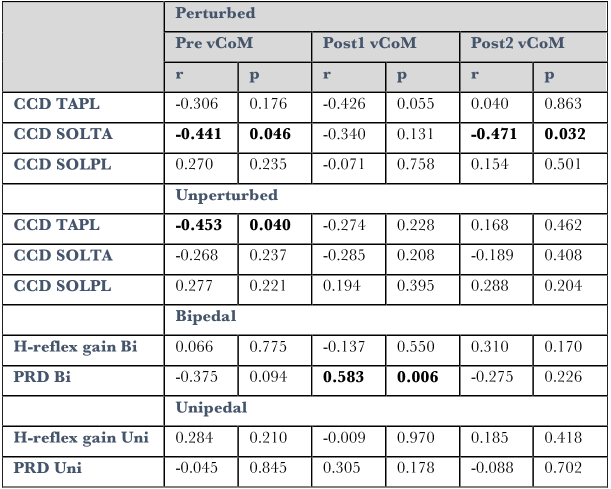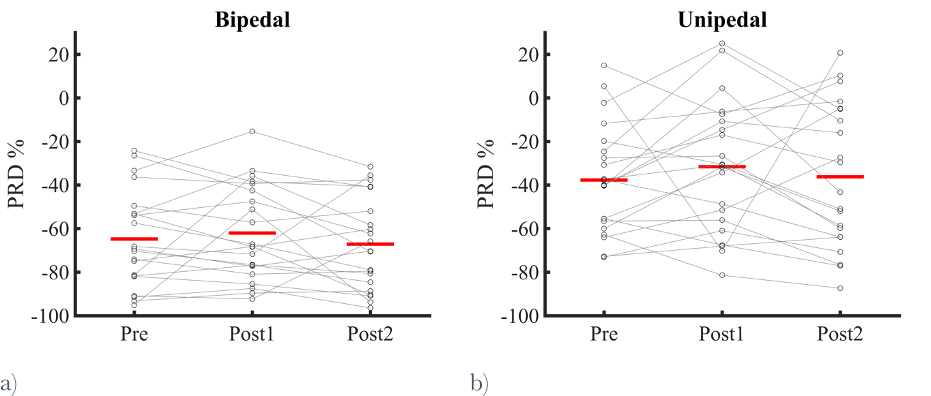
The underlying mechanisms of
improved balance after one and ten
sessions of balance training in older
adults
Leila Alizadehsaravi, Ruud Koster, Wouter Muijres, Huub Maas, Sjoerd M. Bruijn, Jaap H.
van Dieën
Department of Human Movement Sciences, Faculty of Behavioural and Movement Sciences,
Vrije Universiteit Amsterdam, Institute for Brain and Behaviour Amsterdam and Amsterdam
Movement Sciences, Amsterdam, The Netherlands.
.CC-BY-NC-ND 4.0 International licenseperpetuity. It is made available under a
preprint (which was not certified by peer review) is the author/funder, who has granted bioRxiv a license to display the preprint in
The copyright holder for thisthis version posted February 18, 2021. ; https://doi.org/10.1101/2020.10.01.322313doi: bioRxiv preprint

Abstract
Training improves balance control in older adults, but the time course and neural
mechanisms underlying these improvements are unclear. We studied balance robustness and
performance, H-reflex gains, paired reflex depression (PRD), and co-contraction duration
(CCD) in ankle muscles after one and ten training sessions in 22 older adults (+65yrs).
Mediolateral balance robustness, time to balance loss in unipedal standing on a platform with
decreasing rotational stiffness, improved (33%) after one session, with no further improvement
after ten sessions. Balance performance, absolute mediolateral center of mass
velocity, improved (18.75%) after one session in perturbed unipedal standing and after ten
sessions (18.18%) in unperturbed unipedal standing. CCD of soleus/tibialis anterior increased
(16%) after ten sessions. H-reflex gain and PRD excitability did not change. H-reflex gains were
lower and CCD was higher in participants with more robust balance at the last time-point and
CCD was higher in participants with better balance performance at several time-
points. Changes in robustness and performance were uncorrelated with changes in CCD, H-
reflex gain, or PRD. In older adults, balance robustness improved over a single session, while
performance improved gradually over multiple sessions. Changes in co-contraction and
excitability of ankle muscles were not exclusive causes of improved balance.
Keywords: Balance training, center of mass velocity, co-contraction, H-reflex, paired reflex depression, motor
learning, balance performance, postural balance
.CC-BY-NC-ND 4.0 International licenseperpetuity. It is made available under a
preprint (which was not certified by peer review) is the author/funder, who has granted bioRxiv a license to display the preprint in
The copyright holder for thisthis version posted February 18, 2021. ; https://doi.org/10.1101/2020.10.01.322313doi: bioRxiv preprint

Introduction
Balance control is essential to avoid falls during daily-life activities. Impaired balance control
due to aging results in falls, injuries, and loss of independence in older adults
1
. To resolve this
issue, it is important to understand how balance control works and when and how it improves
as a result of training. Balancing requires the central nervous system to act rapidly and
accurately on an array of sensory inputs
2
, consisting of visual, vestibular, and tactile
information, as well as proprioceptive sensory feedback
3
. Balance training leads to improved
balance performance in older adults
4
, observed as a reduction in mediolateral center of mass
velocity during unipedal stance
5
. However, the question how balance training induces changes
in neuromuscular control remains unanswered. Hence, it is important to investigate the relation
between improved balance control in older adults with changes in neural mechanisms at central
and/or peripheral nervous system components.
Changes in balance control with training appear to occur at short-time scales, with
substantial improvements after a single trial and over a single session
6–8
. Previously a rapid
improvement of balance control in young adults after one session of balance training has been
shown
8
, while results of short-term training in older adults were inconsistent
9,10
and most studies
have focused on training over several sessions spread over multiple weeks
4
. Since training effects
were mostly measured before and after the complete training period only, the difference
between single session and several sessions effects of balance training in older adults is unclear.
In addition, most studies assess balance control with measures that capture balance
performance, which quantifies how good people are at minimizing disturbances from an
equilibrium position (often in a non-challenging condition like bipedal stance, or unipedal
stance on a flat surface), for instance by measuring postural sway, in which lower values indicate
better performance
11–14
. There are two problems with this. Firstly, subjects may choose not to
minimize their sway, as higher sway values may be unproblematic, and require less energy
15
.
Secondly, even if subjects choose to minimize their sway, balance performance does not reflect
the capability to avoid balance loss when challenged, i.e. the balance robustness, which
quantifies the largest perturbation that can be resisted. Robustness has received limited
attention in training literature and if it is measured it is mostly done in a dichotomous way
(ability to perform a task, e.g., stand on one leg with eyes closed for 10 s, or not)
16
. For practical
purposes, improved robustness may be more important than improved performance. While
improved balance performance may not necessarily prevent falls, it may indicate improvements
of balance control. Hence, we here chose to study effects of training on both these aspects of
balance control.
.CC-BY-NC-ND 4.0 International licenseperpetuity. It is made available under a
preprint (which was not certified by peer review) is the author/funder, who has granted bioRxiv a license to display the preprint in
The copyright holder for thisthis version posted February 18, 2021. ; https://doi.org/10.1101/2020.10.01.322313doi: bioRxiv preprint

Age-related degenerative processes in the sensory and motor systems induce a shift from
reliance on feedback control to reliance on feedforward strategies, such as co-contraction
17
.
Antagonistic co-contraction can compensate for impaired sensory feedback
18
. Increasing
antagonistic co-contraction when confronted with a challenging balance task is a strategy that
is also used by inexperienced young adults
19,20
. Higher co-contraction in older adults with poor
balance control compared to young adults with better balance control has been shown
previously
19,21
. Balance training can potentially reduce levels of antagonistic co-contraction
22
.
And thus, it could be expected that balance training will reduce co-contraction in older adults.
We note here that many different methods have been used to assess co-contraction in the
literature. In the studies mentioned above, the index of co-contraction reflected either the
magnitude of antagonistic co-contraction
20
or its magnitude and duration combined
19,21,22
.
Alterations of the H-reflex indicate an adjusted motoneuron output after processing of Ia
afferent input at the spinal cord
23
. With age, postural modulation of H-reflexes is reduced
19,24–
26
and this may be functionally related to a declined balance performance in older adults
27
.
Balance training in young adults has been reported to decrease the soleus (SOL) H-reflex
28–31
.
While both young and older adults are capable to down-train the SOL H-reflex
32
, it is unclear
whether balance training also causes such down-regulation of the H-reflex in older adults.
Unfortunately, only few studies have addressed the effect of training on the H-reflex in older
adults. Scaglioni et al. showed no changes of the H-reflex after 16 weeks of strength training
in older adults
33
, Ruffieux et al. found no effects of training on H-reflex after 5 weeks
34
, and
Lauber et al. showed an enhanced H-reflex after 12 weeks of alpine skiing
35
. Decreases in the
H-reflex are thought to reflect a reduced effect of spinal feedback circuitry on motor control,
coinciding with increased supraspinal control
30,36
. However, supraspinal mechanisms also
affect the excitability of the alfa motoneuron pool and therefore the H-reflex gain. This
hampers the interpretation of the H-reflex. Therefore, measurements of paired reflex
depression (PRD) were added in this study to provide an insight into peripherally induced
inhibition which would more exclusively reflect changes in peripherally induced pre-synaptic
inhibition
37–39
. The second H-reflex in PRD measurements is assumed to be influenced by the
synchronous activation of the spindle’s afferents during the first H-reflex. Using PRD, the
influence of primary spindle afferent feedback and therefore, activation history of the Ia
afferents on the motoneuron pool output can be studied
37
. Among middle aged adults (~44
years), subjects with long-term Tai Chi practice showed better balance performance and,
despite of a similar H-reflex, a larger PRD
40
. These authors assumed that a reduced second H-
.CC-BY-NC-ND 4.0 International licenseperpetuity. It is made available under a
preprint (which was not certified by peer review) is the author/funder, who has granted bioRxiv a license to display the preprint in
The copyright holder for thisthis version posted February 18, 2021. ; https://doi.org/10.1101/2020.10.01.322313doi: bioRxiv preprint

reflex avoids overcorrection and prevents unwanted oscillations. Hence, increased PRD might
be expected as a result of balance training.
The aims of the present study were twofold; first, we aimed to assess the functional benefits
of one session and ten sessions of balance training in older adults. To do so, we assessed changes
in balance robustness (as the duration that participants were able to keep their body balanced
while surface stiffness was decreased) and balance performance (measured as the mean absolute
value of the mediolateral center of mass velocity during unipedal balancing). Second, we aimed
to explore the associations between the changes in balance robustness and balance performance
with co-contraction duration, H-reflex gain and PRD after one session and ten sessions of
training. We hypothesized that balance robustness and performance would be improved
significantly after ten sessions of training, and that such improvements would be accompanied
by changes, such as decreased co-contraction duration, lower H-reflex gains and stronger PRD.
Methods
Participants
Twenty-two healthy older adults (age: 72.6 ± 4.2 years, length: 1.71 ± 0.09 m, weight: 75.6
± 13.3 kg; mean ± SD, 11 females and 11 males) participated in this study. This is comparable
to similar studies
41,42
and in accordance with a required sample size of fifteen based on power
analysis for an F test of a within factor repeated measure, assuming an effect size of 0.44
4
and
correlation among repeated measures of 0.1 (
!" # "$%&
, G*power 3.1.9.2, Düsseldorf,
Germany). To ensure participant safety and data reliability, exclusion criteria included: an
inability to stand and walk for 3 minutes without walking aid, cognitive impairments (MMSE
< 24), depression (GFS > 5), obesity (BMI > 30), orthopedic, neurological, and cardiovascular
disease, use of medication that affects balance, and severe auditory & visual impairments. To
prevent ceiling effects in balance robustness and performance and limited training gains,
participants practicing sports that explicitly include balance components (e.g. Yoga, Pilates)
were excluded as well
43
. To prevent obscuring any training effects, participants were asked to
keep their normal activity levels in their daily life throughout the experiment. All participants
provided written informed consent prior to participation and the experimental procedures were
approved by the ethical review board of the Faculty of Behaviour and Movement Sciences,
Vrije Universiteit Amsterdam (VCWE-2018-171).
Experimental procedures
The protocol included an initial measurement session to determine baseline state (Pre), a
measurement after one session of balance training (30 min; Post1), and after ten sessions (45
minutes per session; Post2). The protocol was concluded with a Retention assessment two weeks
.CC-BY-NC-ND 4.0 International licenseperpetuity. It is made available under a
preprint (which was not certified by peer review) is the author/funder, who has granted bioRxiv a license to display the preprint in
The copyright holder for thisthis version posted February 18, 2021. ; https://doi.org/10.1101/2020.10.01.322313doi: bioRxiv preprint







![Figure 3: The duration of balancing in [s], and corresponding stiffness as a function of mgh (body mass times gravity times the height of the body center of mass) and time.](/figures/figure-3-the-duration-of-balancing-in-s-and-corresponding-370keak4.png)




